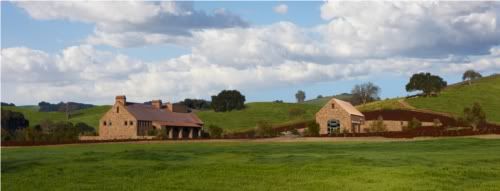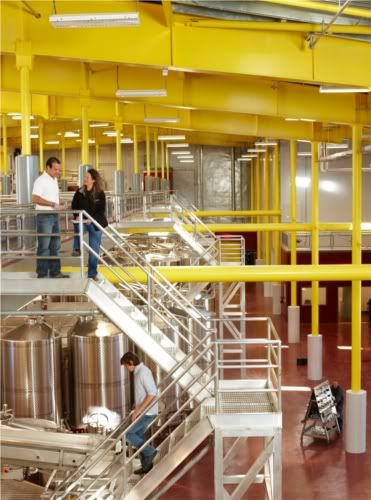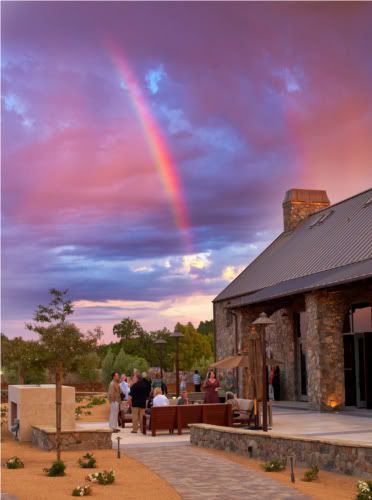The wine industry boasts many people and companies who would like to make the world a better place. Making great wine for our enjoyment certainly helps in that effort, but there is much more to improving our situation on the planet than knowing how to create a good time in a bottle.
Niner Wine Estates in Paso Robles has gone above and beyond the call of wine, at least according to the U.S. Green Building Council. Niner's state-of-the-art facility has been honored with the organization's LEED Silver Certification. This makes Niner one of only four wineries in California - and the first in the Central Coast AVA - to be recognized in this manner for designing and operating their facility with extreme greenness in mind.
LEED stands for Leadership in Energy and Environmental Design. It's a building rating program, a nationally accepted benchmark for evaluating the design, construction and operation of high performance green buildings. Buildings are certified based on superior performance in energy efficiency, sustainable site development, water efficiency, selection of materials and indoor environmental quality.
 Niner was awarded the LEED Silver Certification for its Paso Robles complex, which includes a Hospitality Center, Demonstration Winery and Production Winery totalling about 75,000 square feet on 140 acres of Westside real estate.
Niner was awarded the LEED Silver Certification for its Paso Robles complex, which includes a Hospitality Center, Demonstration Winery and Production Winery totalling about 75,000 square feet on 140 acres of Westside real estate.
Niner's owners Richard and Pam Niner were over the moon about the certification. According to Rick Fedrizzi, President, CEO and Founding Chair of the U.S. Green Building Council, so was the council. "The work of innovative building projects such as Niner Wine Estates is a fundamental driving force in (the green building) movement," said Fedrizzi.
 A tour of the facility showed the different facets which allowed Niner to achieve the honor. Niner's enologist, Lorna Kreutz, guided me through the entire Production Winery. She took it all in stride, but I was agog at the pristine conditions I found in the tank room. I guessed that since the place is fairly new, it just hadn't had time to take on a "lived-in" look. "No," said Lorna, "we work pretty hard to keep it looking nice." I spied what looked like a couple of scraps of paper on the floor, but I was wrong again. "Those are actually pieces of tape placed there for measurement purposes," she said. "When the crew is done working, they'll take those up."
A tour of the facility showed the different facets which allowed Niner to achieve the honor. Niner's enologist, Lorna Kreutz, guided me through the entire Production Winery. She took it all in stride, but I was agog at the pristine conditions I found in the tank room. I guessed that since the place is fairly new, it just hadn't had time to take on a "lived-in" look. "No," said Lorna, "we work pretty hard to keep it looking nice." I spied what looked like a couple of scraps of paper on the floor, but I was wrong again. "Those are actually pieces of tape placed there for measurement purposes," she said. "When the crew is done working, they'll take those up."
The building, of course, is not only clean - it's green. It's built into a cut in the hillside to help keep it cool naturally. Insulated concrete walls help with that, too. The cellar has a system which brings in night air, and that also helps reduce cooling needs.
Lorna explained that wastewater is treated and recycled for use as vineyard irrigation, and rainwater is also collected for that purpose.
The building materials are either recycled or locally manufactured, the multi-level design allows gravity to do the work of pumps and even the paint and flooring uses materials which enhance not only the indoor environment, but the one outside as well.
Niner Wine Estates has proven that a technologically advanced facility can also be one that fits well into its surroundings and one that keeps the environment at the forefront. All this comes at some cost. As I poked around various places in Paso Robles, I heard the facility and its "$50 million pricetag" talked about with some pride and, I suspect, some jealousy. I'm sure any winemaker would love to have this kind of winery as a workplace. Niner's winemaker Amanda Cramer should get some of the credit for this design, as she had a hand in creating the Niner winery as a functional wonder of the wine world.
Richard Niner is the visionary here, and he's the guy who put his money where his dreams are. His belief that world class wines are the sum total of great people, great vineyards, great tools and great ideas is the driving force behind Niner Wine Estates.
Niner Wine Estates in Paso Robles has gone above and beyond the call of wine, at least according to the U.S. Green Building Council. Niner's state-of-the-art facility has been honored with the organization's LEED Silver Certification. This makes Niner one of only four wineries in California - and the first in the Central Coast AVA - to be recognized in this manner for designing and operating their facility with extreme greenness in mind.
LEED stands for Leadership in Energy and Environmental Design. It's a building rating program, a nationally accepted benchmark for evaluating the design, construction and operation of high performance green buildings. Buildings are certified based on superior performance in energy efficiency, sustainable site development, water efficiency, selection of materials and indoor environmental quality.
 Niner was awarded the LEED Silver Certification for its Paso Robles complex, which includes a Hospitality Center, Demonstration Winery and Production Winery totalling about 75,000 square feet on 140 acres of Westside real estate.
Niner was awarded the LEED Silver Certification for its Paso Robles complex, which includes a Hospitality Center, Demonstration Winery and Production Winery totalling about 75,000 square feet on 140 acres of Westside real estate.Niner's owners Richard and Pam Niner were over the moon about the certification. According to Rick Fedrizzi, President, CEO and Founding Chair of the U.S. Green Building Council, so was the council. "The work of innovative building projects such as Niner Wine Estates is a fundamental driving force in (the green building) movement," said Fedrizzi.
 A tour of the facility showed the different facets which allowed Niner to achieve the honor. Niner's enologist, Lorna Kreutz, guided me through the entire Production Winery. She took it all in stride, but I was agog at the pristine conditions I found in the tank room. I guessed that since the place is fairly new, it just hadn't had time to take on a "lived-in" look. "No," said Lorna, "we work pretty hard to keep it looking nice." I spied what looked like a couple of scraps of paper on the floor, but I was wrong again. "Those are actually pieces of tape placed there for measurement purposes," she said. "When the crew is done working, they'll take those up."
A tour of the facility showed the different facets which allowed Niner to achieve the honor. Niner's enologist, Lorna Kreutz, guided me through the entire Production Winery. She took it all in stride, but I was agog at the pristine conditions I found in the tank room. I guessed that since the place is fairly new, it just hadn't had time to take on a "lived-in" look. "No," said Lorna, "we work pretty hard to keep it looking nice." I spied what looked like a couple of scraps of paper on the floor, but I was wrong again. "Those are actually pieces of tape placed there for measurement purposes," she said. "When the crew is done working, they'll take those up."The building, of course, is not only clean - it's green. It's built into a cut in the hillside to help keep it cool naturally. Insulated concrete walls help with that, too. The cellar has a system which brings in night air, and that also helps reduce cooling needs.
Lorna explained that wastewater is treated and recycled for use as vineyard irrigation, and rainwater is also collected for that purpose.
The building materials are either recycled or locally manufactured, the multi-level design allows gravity to do the work of pumps and even the paint and flooring uses materials which enhance not only the indoor environment, but the one outside as well.
Niner Wine Estates has proven that a technologically advanced facility can also be one that fits well into its surroundings and one that keeps the environment at the forefront. All this comes at some cost. As I poked around various places in Paso Robles, I heard the facility and its "$50 million pricetag" talked about with some pride and, I suspect, some jealousy. I'm sure any winemaker would love to have this kind of winery as a workplace. Niner's winemaker Amanda Cramer should get some of the credit for this design, as she had a hand in creating the Niner winery as a functional wonder of the wine world.
Richard Niner is the visionary here, and he's the guy who put his money where his dreams are. His belief that world class wines are the sum total of great people, great vineyards, great tools and great ideas is the driving force behind Niner Wine Estates.

